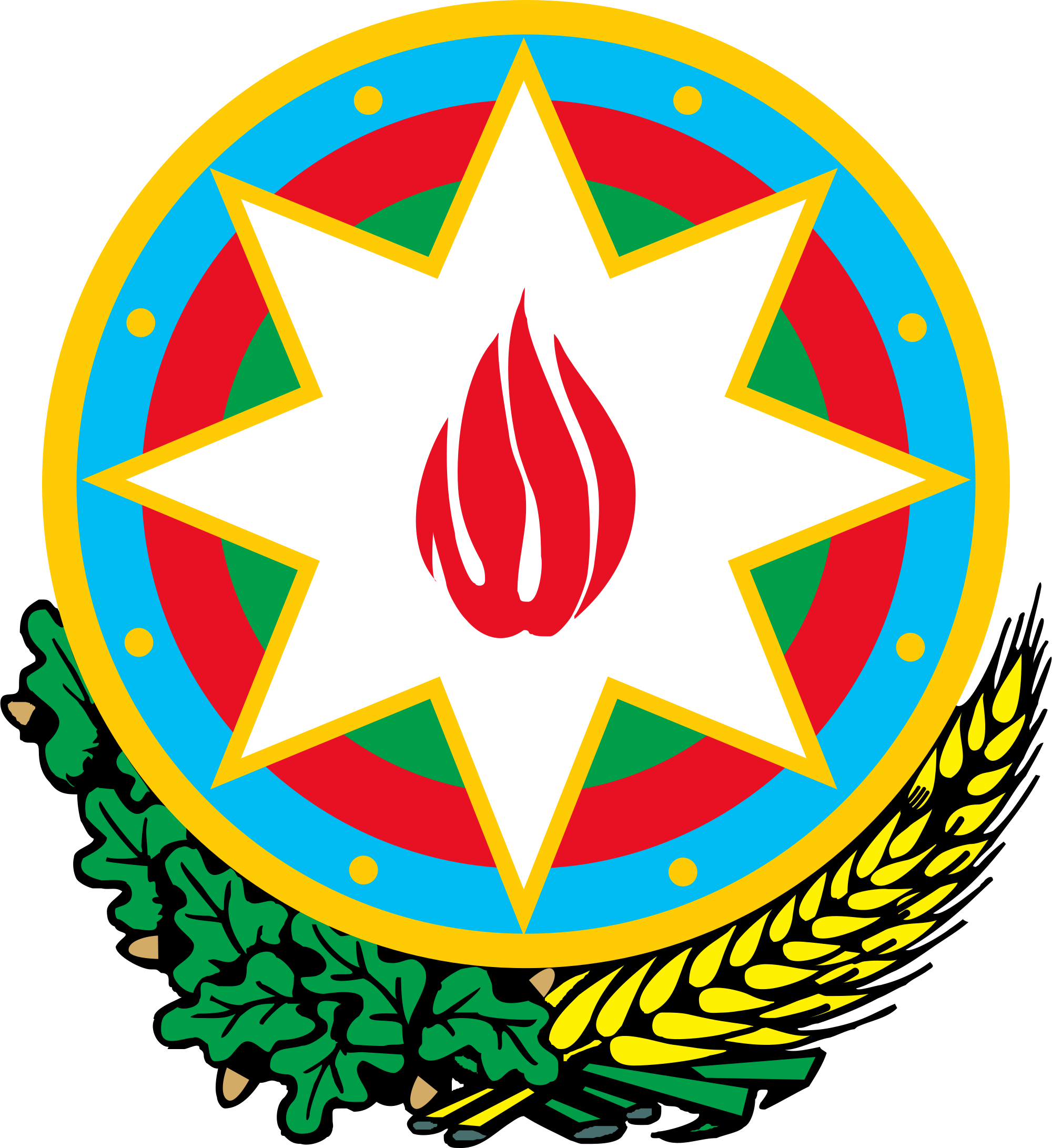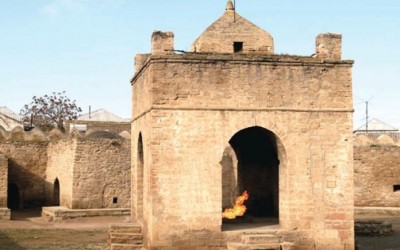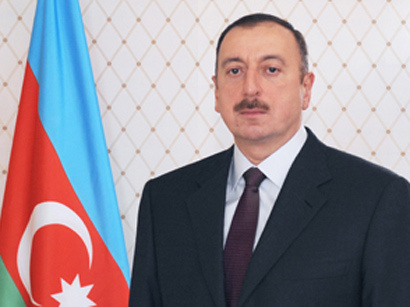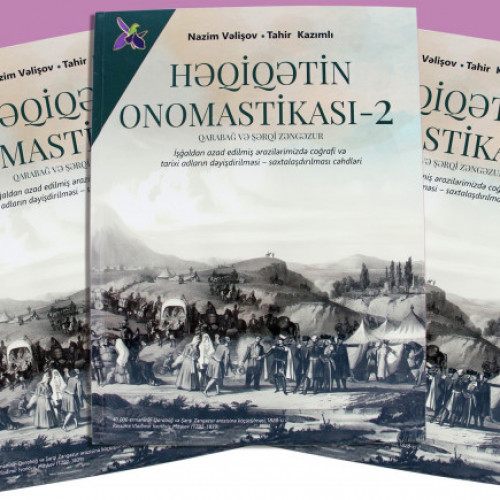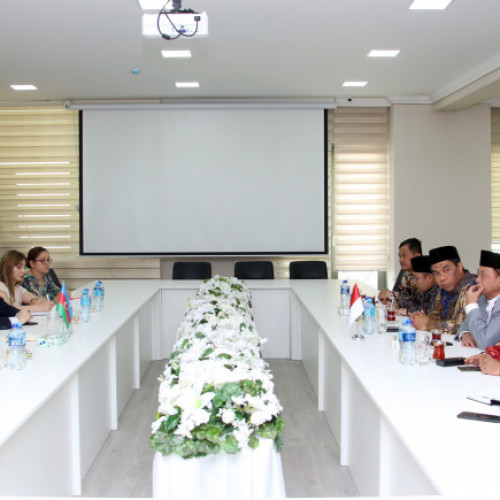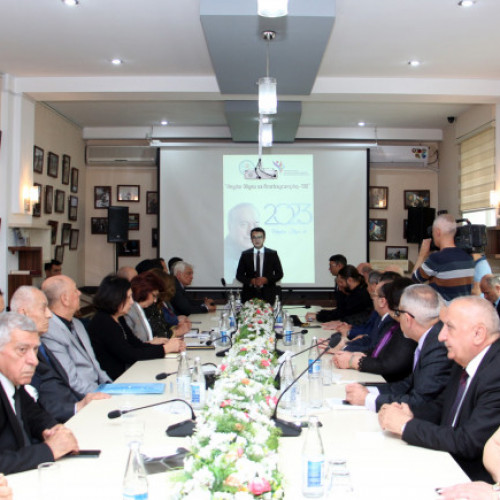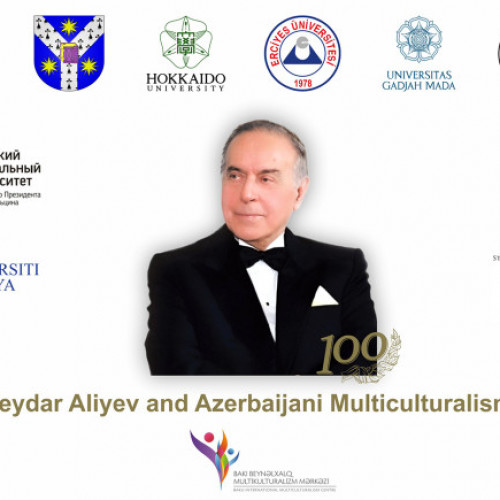Islam in Azerbaijan

The beginning of Islam’s spread in Azerbaijan is associated with Arab conquests. Prior to the Arab conquests, the South Azerbaijan was part of the Sasanian Empire, while the Caucasian Albania, which existed in the North Azerbaijan, had become a vassal state of the Sasanian Empire. In the pre-Islamic period, fire-worshipping and Zoroastrianism were dominant religions in the South Azerbaijan, while Christianity was dominant in the Caucasian Albania. Despite Christianity having the status of state religion in the Caucasian Albania, the majority of its population followed ancient pre‑Christianity beliefs. In particular, different pagan beliefs and fire‑worshipping was widely practiced by the middle and poor classes.
As we can see, the religious landscape of Azerbaijan on the eve of Arab conquests was very complicated. The Arab conquests radically changed this landscape, leading to the spread of Islam, a new religion, which would unite Azerbaijanis and be instrumental in the formation of their national consciousness and moral values. Let’s have a look at how this historical process started.
Emerging after the demise of Prophet Muhammad in 632, the Arab Caliphate achieved success within a short span of time through consecutive big victories over Byzantine and Sasanian Empires, the mightiest powers of the time. Inspired by these victories, the Arab conquerors continued their advance and conquered increasingly larger territories. Thus, in 639, the Caliphate troops under the command of Hudhayfah entered the South Azerbaijan for the first time and encountered strong resistance. In the same year, Isfandyadh, the son of marzban (ed.: a viceroy of a military‑administrative district along the border) Farrokhzad was defeated and captured by Arabs. His brother Bahram recruited an army to fight back, but Arabs took the victory again. After this, marzban Isfandyadh was forced to sign a treaty with Arabs on behalf of the population in 644. According to the treaty, Azerbaijanis had to be subordinate to Arabs, pay a tax, and host Arab soldiers at their homes for a day and night. In return, Arabs undertook not to touch religious beliefs of the locals and not to interfere with their customs and traditions. Furthermore, those, who wanted to leave the country, were given respite until they found refuge and the locals, who voluntarily entered military service in the Arab army, were exempted from tax for that year.
Arabs attacked the North Azerbaijan in 639. The Arab troops under the command of Bukair ibn Abdullah raided the North Azerbaijan, but faced strong resistance from the local population. The fighting lasted for several years. Eventually, in 642, Arabs managed to occupy Mughan, albeit with difficulty. Arabs signed a treaty with the locals here, too. This treaty repeated the provisions of the treaty signed with marzban Isfandyadh, the only difference being in the amount of jizya (tax collected from non-Muslims).
Despite the treaties, Arabs could not subjugate the population of Azerbaijan with ease. After the departure of the Arab troops, the locals rebelled, not wanting to comply with the provisions of the treaties signed with Arabs. This forced the Arab Caliphate to send a new army to the region. For instance, in 646, the Arab army led by Walid ibn Uqbah advanced on the South Azerbaijan and broke the resistance of the locals. They signed a new treaty with the local population.
In the same year, the Arab army led by Salman ibn Rabiah attacked the North Azerbaijan. This time, the Caliphate army marched from Nakhchivan towards Shaki and Gorus, captured Beylagan, Barda, Shamkir, Gabala, Shaki and Shirvan, and forced the locals to pay a tax.
Despite these continuous raids by Arab troops, the Caliphate completed the occupation of Azerbaijan only after 90 years of fierce struggle. The relentless attacks by Arabs resulted in the collapse of the Sasanian Empire in 651, leading to the South Azerbaijan’s incorporation into the Caliphate.
The Caucasian Albania, which covered the territory of the North Azerbaijan, managed to maintain partial independence thanks to the wise policy of Albanian ruler Javanshir. Earlier, Javanshir had shown himself as a brave and talented commander during the fights against Arabs within the Sasanian army. After the collapse of the Sasanian Empire, this prominent statesman tried to regain the previous might of the Caucasian Albania. However, his reign coincided with a very complicated historical period. The Caucasian Albania was attacked by Caliphate troops from on side and by Khazars from the other. Considering the situation, Javanshir took a farsighted step and accepted to be a vassal of the Arab Caliphate, thus maintaining independence in internal affairs of the country.
Javanshir was assassinated in 681 (according to some sources, in 680). His death took a heavy toll on the subsequent fate of the Caucasian Albania. After his death, the Arab Caliphate began to gradually take away the internal independence of this ancient Azerbaijani state. Ultimately, the Caucasian Albania completely lost its independence and was incorporated into the Caliphate in 705.
Having talked about the establishment of the Caliphate rule in the Azerbaijani lands, let’s now look at the process and causes of the spread of Islam, the new religion brought along by Arabs, in our country.
Looking the at the map of the spread of Islam in Azerbaijan, we can see that this religion was spreading fast in the South Azerbaijan, where fire-worshiping and paganism was dominant, and in the flatlands of the North Azerbaijan. Islam had a weak influence in the mountainous and foothill areas of the North Azerbaijan, where Christianity was followed, because Arabs respected the beliefs of Jews and Christians, who were considered People of the Book (i.e. followers of sacred books such as Torah, Psalms and Bible), in the occupied countries, including Azerbaijan. Therefore, Christianity survived in the mountainous and foothill areas of our country.
Unlike the People of the Book, adherents of other beliefs, including fire-worshippers and pagans were persecuted and oppressed by Arabs. Thus, Islam became a dominant religion in the South Azerbaijan and in the mountainous and foothill areas of the North Azerbaijan. However, according to famous Russian orientalist Vasily Bartold, Arabs did not touch fire-worshippers, either, and spread Islam among them peacefully.
It would not be right to attribute Islam’s spread solely to Muslims’ treatment of the followers of other religions. Islam’s success in the region is associated with different causes. Prior to Arab invasions, the people of Azerbaijan greatly suffered from Sasanian-Byzantine wars and Khazars’ attacks. Moreover, the local people were tired of heavy taxes collected by the Sasanian state. Crushed under heavy taxes and tired of never-ceasing wars, the population placed their trust and hope on Arabs, who promised peace and happiness through the new religion, because Arabs initially did not touch the religious beliefs and customs and traditions of the locals in the occupied territories after collecting a tax. Also, during the tenures of the first four caliphs, the amount of the tax was lower than that collected by Sasanians. Unlike Sasanians, Arabs collected the tax from the entire country rather than individuals. As a result, the above-mentioned facts elicited a feeling of sympathy in the locals for Islam.
Different segments of the populations had different attitude towards the new religion. For instance, the ruling class, who correctly understood Islam’s moral values, educational benefits and prospects and tried to maintain their property and privileges, accepted this religion without hesitation. Being aware of the Arab Caliphate’s fondness for trade and art, merchants and artists converted to the new religion without delay. Poor urban dwellers, villagers and the poor segment of the population received assistance and concessions after accepting Islam, which led to the spread of the new religion among ordinary people.
According to prominent Azerbaijani orientalist scholar Ziya Bunyadov, Islam became the dominant religion in our country in the early 8th century. In the opinion of some researchers, the process of spread of Islam in our country continued until the second half of the 10th century.

Muslim places of worship played a big part in the spread of Islam. Arabs maintained military units in Ardabil, Maragha, Beylagan, Barzand, Barda, Derbent, Nakhchivan and other strategically important cities of Azerbaijan. Mosques were routinely built in these territories, which hosted military units. According to historical sources, Azerbaijan’s first mosque was erected in Ardabil. Already in the 10th to 11th centuries, there were Muslim temples in all settlements of the country. For instance, in his book titled “The Best of Classification for the Knowledge of Climates”, Arab traveler and geographer Shamsaddin Abu Abdullah al-Maqdisi (946/947‑approx.1000) provides detailed information about the large mosques in Tabriz, Marand, Urmia, Shamakhi, Gabala, Shaki and other cities of Azerbaijan.
Madrasas (ed.: Muslim religious education facilities that teach different secular subjects in addition to religious subjects) operating under mosques contributed to the strengthening of Islam in the conquered territories. According to the sources, the mighty Azerbaijani state of Atabegs (1136-1225) paid special attention to the construction of madrasas. Popular madrasas of the Atabegs period were the “al-Faraj al-Khuwayya” madrasa in Khoy city and the “Atabegiyya” and “al-Qadi” madrasas in Maragha. The madrasa, which was part of the Momine Khatun Mausoleum in Nakhchivan, was among the famous educational institutions of that era.
Thus, the religion of Islam spread in Azerbaijan for different reasons, including progressive ideas that it carried, and won a special place in the hearts of our people by ousting all other religions from the historical scene. Thus, the people of Azerbaijan joined the Islamic civilization, and this event had a positive impact on the fate of our people. Because the mixture of different peoples within the Arab Caliphate, which spanned from Spain to India, led to the emergence of a rich Islamic culture. The 8th and 9th centuries went down in history as the Golden Age of Islam or Muslim Renaissance. At the time, the Islamic geography was home to the largest educational institutions, medical facilities and science centers, and Muslim scientists were making great discoveries.
The progress in the Islamic world during this period also led to the development and further enrichment of the ancient culture of Azerbaijan. The Azerbaijani people themselves also made great contributions to this culture, and gave great scientists, cultural figures, artists and thinkers not only to the Muslim world, but also to the humankind, in general.
Azerbaijan truly experienced its period of renaissance during the 11th to 12th centuries. Some of the prominent Azerbaijanis, who lived and created at that time, were philosophers Abulhasan Bahmanyar (993-1066) and Khatib Tabrizi (1030-1108), famous astronomer of the period Fazil Faridaddin Shirvani (12th century), poets Qatran Tabrizi (1010-1080), Falaki Shirvani (1108‑1146), Afzaladdin Khagani (1120-1199), and, lastly, great master of word Nizami Ganjavi (1141-1209).

The people of Azerbaijan continued to give prominent personalities to the Islamic world in the later periods, as well. One of such personalities is prominent 13th-century scientist Nasir al-Din al-Tusi (1201‑1274), who possessed encyclopedic knowledge and founded the largest observatory of his era in Maragha city of Azerbaijan in 1259.
In the Middle Ages, Azerbaijani scientists were renowned in the field secular sciences, as well as Islamic sciences. Azerbaijani religious scholars such as Abdullah ibn al-Husayn al-Bardai Abu Said al-Hanafi (died in 929), Abu Bakr Ahmad ibn Harun ibn Ruh al-Bardaji (d. 914), Makki ibn Ahmad Sadawayh al-Bardai (d. 914), Abul Ullah ibn Abdullah Ali al-Khalili al-Qazvini (d. 1054), Budayl al-Barzandi (d. 1082), Abulfazl al-Urmavi (d. 1152), Ismail Ganjavi (d. 1192), Abul Wafa Khalil ibn Hasan ibn Muhammad al-Marandi (d. 1012), Abul Qasim az-Zanjani (d. 1066), Abu Bakr Muhammad al‑Husayni (d. 476 AH/1083) and Muhammad ibn Abdullah al‑Bardai (d. 6thAH/12th century) were well-known.
Azerbaijan is also considered the homeland of several Sufi orders. Sufism (or Tasawwuf), as a religious‑mystical and philosophical-moral movement calling for asceticism and spiritual purity, played a significant role in the history of socio-philosophical thought of Azerbaijan.
The history of Sufism in Azerbaijan begins from the 10th century. During the very early stages of the development of Sufism, Azerbaijani Sufis such as Ibn Bakuyya Baba Kuhi (d. 1050-51) and his brother Husayn Shirvani (d. 1074) had a great reputation. Already in the 13th century, hundreds of Sufi centers were functioning in Azerbaijan. According to 13th-century author Muhammad Ibn Munawwar, followers of Sufi sheikh Abu Said Abulkhair had more than 400 khanqahs (places for the congregation) in Shirvan only. One of such khanqahs that survived to the present day is Pir Husayn Khanqah. This religious-historical monument is located in Qubalibalaoglan village of Hajigabul district and was built around the mausoleum of Sheikh Husayn Shirvani. Constructed in the 11th to 12th centuries, Pir Husayn Khanaqah evolved into a large complex in the 13th century.
Starting from the 12th century, a number of Sufi orders originated in Azerbaijan and spread to the Islamic world. One of such orders is Suhrawardism founded by Shihab al-Din Suhrawardi (1144‑1234), who was born in Suhraward city of Zanjan province of the South Azerbaijan. He comprehensively described the moral norms and ethics of Sufis in his works. He opposed the type of dhikr (remembering Allah) called “sema” (ed.: dhikr by whirling to musical beats and melodies), only considering the dhikrs called “khafi” (translates into “concealed” or “silent”) and “jahri” (translates into “in a loud voice”) to be acceptable.
Another Sufi order that originated in Azerbaijan is Hurufism (ed.: “Huruf” means “Alphabetic letters” in Arabic). This order was established by Sheikh Fazlullah Jalaluddin Naimi in the late 14th century. Hurufis believed in the manifestation of Allah in nature, objects, words, and particularly in humans. According to their teachings, Fazlullah was the manifestation, embodiment and regent of Allah. Followers of this order noted that Allah is manifested as a word, the letters of the Arabic alphabet are sacred, and they can be used to reveal the secrets of the world, and attached special meaning to numbers such as 4, 7, 28 and 32. One of the prominent figures of Hurufism was great Azerbaijani poet Imadaddin Nasimi (1369-1417).
During the same period as the emergence of Hurufism, another Sufi order called Khalwatism originated. This order was founded by Abu Abdullah Sirajuddin Omar Khalwati (d. 1349 or 1397) in Shamakhi. Thanks to the efforts of well-known Azerbaijani Sufi Seyid Yahya Bakuvi, the Khalwati order transcended the borders of Azerbaijan and found a lot of supporters in other Muslim countries. Khalwati dervishes (ascetic Muslim monks) wore black or green rectangular turbans, which distinguished them from the followers of other Sufi orders.

The Sufi order, which played a great role in the history of statehood of the Azerbaijani people and had a significant impact of the development of our art, literature, architecture and culture in general, is, of course, the Safaviyya order. This Sufi order was founded by Sheikh Safiaddin al‑Ishaq al-Musawi al-Ardabili (1252-1334) in Ardabil city of the South Azerbaijan at the end of the 13th century. During the tenure of Sheikh Heydar (1460-1488), the sixth head of the order, innovations took place in the order. The followers of the order began wearing a headwear with twelve stripes to indicate their belonging to the Shia sect. These stripes signified the twelve Shia imams. Safavids were also known as Qizilbashs (redheads) due to the red color of this headwear. Over time, the Safaviyya order grew in influence, and a mighty Azerbaijani state of Safavids was founded on the basis of its ideology. Being one of the most glorious and brightest pages of our history, the Safavid state was founded by prominent Azerbaijani ruler in 1501 and poet Shah Ismayil Khatai and existed until 1736.
Speaking about the history of Islam in Azerbaijan, one should necessarily mention the period of Czarist Russia. Because after the Russian occupation of the Caucasian territories, including the North Azerbaijan, in the early 19th century, a series of measures were implemented by the Czarist government in the religious sphere. Firstly, spiritual institutions were established to control the religious life of Muslims. On April 5, 1872, Russian czar Alexander II approved the statutes “On the governance of the Shia Muslim clergy of the Caucasus” and “On the governance of the Sunni Muslim clergy of the Caucasus”. Thus, on January 2, 1873, the Transcaucasian Shia Spiritual Administration and the Transcaucasian Sunni Spiritual Administration were founded. These Boards had jurisdiction over Muslims living in Baku, Elisabethpol (Ganja), Tbilisi and Erivan governorates and were based in Tbilisi. The Shia Spiritual Administration was headed by a sheikh-ul-Islam, while the Sunni Spiritual Administration was headed by a mufti. Both sheikh‑ul-Islam and mufti were appointed by the Czarist government and were accountable to the viceroy of the Caucasus.
After the establishment of Azerbaijan Democratic Republic on May 28, 1918, increased attention was paid to the role of the sheikh-ul-Islam and the mufti in the resolution of religious matters. By the decision of the Republican government issued on June 18, 1918, the sheikh‑ul‑Islam and the mufti were given a decisive vote in the discussion of Islam-related matters at the Council of Ministers. The Ministry of Public Education and Religious Affairs was created within the second government cabinet of Fatali khan Khoyski. After this Ministry’s request to the sheikh‑ul‑Islam and the mufti on August 10, 1918, the Transcaucasian Shia Spiritual Administration and the Transcaucasian Sunni Spiritual Administration were moved from Tbilisi to Ganja. The Shia and Sunni Spiritual Administrations were merged by the decision of the heads of both Administrations dated September 1, 1918. The newly founded spiritual institution was called Mashyakhat-i Islamiyyah (translates into “Sheiks, aksakals, leaders of Islam”). According to the staffing table presented to the Ministry of Public Education and Religious Affairs, the Mashyakhat-i Islamiyyah was supposed to consist of fifteen people, including two chairpersons, two board members, a secretary and two clerks. By its decision of October 8, 1918, the government assigned a monthly salary of 2,500 manat for the mufti and the sheikh-ul-Islam, and moved their clerical offices, along with those of other state and government bodies, to Baku. The salaries of the mufti and the sheikh-ul-Islam were later set at 1,500 manat.
Following the relocation of the Mashyakhat-i Islamiyyah to Baku, the process of specifying its structure was continued. It was decided that the Mashyakhat-i Islamiyyah would be co-chaired by the sheikh-ul-Islam and the mufti. Under the order issued by the government in March 1920, the co-chairs were given the same status as a deputy minister.
As a result of Bolshevik occupation of Azerbaijan on April 28, 1920, Soviet rule was established in the country. Pursuing the policy of atheism, the Bolshevik-Communist government targeted all religions, including Islam. As a result, the activities of religions organizations were ceased, the Mashyakhat-i Islamiyyah was abolished, Muslim religious figures and scholars were persecuted, most places of worship and shrines were closed down or demolished, mosques were converted into storehouses and museums, sacred books were burnt, and serious efforts were made using all tools to cause the religion to be forgotten and to separate people from their religious roots.
However, during the years of World War II, some changes took place in the Soviet government’s policy on religion. Reforms were implemented to exercise an effective control over the existing religious situation, as well as to gain popularity among the population during the difficult years of war. During this period, establishment of religious institutions was deemed necessary. As a result, the spiritual institution was reinstated to regulate the religious life of Caucasian Muslims. By Decision No.17 of the Presidium of the Supreme Soviet of the USSR issued on April 14, 1944, the Baku-based Transcaucasian Muslims Spiritual Administration was founded. On May 25-28, 1944, the first congress of Transcaucasian Muslims was held in Baku. Considering the ratio between the numbers of Shia and Sunni believers among the Transcaucasian Muslims, the seven Board members of this institution included four members elected from among Shia Muslims, and three members from among Sunni Muslims. The chairperson of the institution was from among the Shia members, who constituted the majority, and was granted the titled of sheik‑ul-Islam. A Sunni member held the position of deputy chairman and was granted the title of mufti.
In 1989, Baku Islamic Madrasa was founded under the Transcaucasian Muslims Spiritual Administration. In 1991, Baku Islamic Institute (currently operating as Baku Islamic University) was created on the basis of this educational institution.
After Azerbaijani people’s restoration of their state independence in 1991, a process of return to traditional Islamic values started. Firstly, the Muslim places of worship and shrines closed down during the Soviet era were re-opened and new mosques were built in all regions of our country.
Today, the number of mosques is over 2,000, compared to only 17 mosques functioning in our country during the Soviet period. More than 300 of these mosques are protected as a historical and cultural monument. The policy of caring for Islamic values and Islam’s historical and religious monuments was founded by National Leader Heydar Aliyev and is successfully continued by President Ilham Aliyev today. As a result of this care, the Bibiheybat, Tazapir, Ajdarbay and Shamakhi Juma mosques and the Imamzade complex in Ganja underwent an overhaul, and the Heydar Mosque, the most spectacular temple in the South Caucasus, was built in our capital city.
Besides, after the fall of the Soviet Empire, hundreds of new Muslim religious communities began functioning in our country, and the Caucasian Muslims Office was established on the basis of the Transcaucasian Muslim Spiritual Administration. The Muslim religious communities functioning in the Republic of Azerbaijan are united under the umbrella of this historical religious center and are subordinate to it in organizational matters.
During the period of independence, a favorable environment was created in Azerbaijan for the scientific study of Islam and establishment of appropriate educational institutions. In 1992, the Faculty of Theology was established at Baku State University (BSU). On February 9, 2018, Azerbaijan Institute of Theology was founded under the State Committee for Work with Religious Organizations by the Order of the President of the Republic of Azerbaijan. The theology faculty of BSU was incorporated into the structure of the new institute. Also, secondary religious education institutions and courses within religious communities were opened in different regions of our country to teach the doctrines of Islam.
The above-mentioned facts are an indication that, in modern Azerbaijan, the state provides ample opportunities for the preservation of traditional Islamic values.
Establishing and developing relations with the Islamic world is a priority area of the foreign policy of our state. It is no coincidence that the Organization of the Islamic Conference (ed.: renamed as the Organization of Islamic Cooperation (OIC) in 2011) was the first international institution joined by Azerbaijan.
After the restoration of independence, our state was the first post-Soviet country to apply for membership of the OIC, and, consequently, Azerbaijan was admitted as a full member of the Organization of the Islamic Conference during the Sixth Islamic Conference held in Senegal’s capital Dakar on December 8, 1991. Azerbaijan was also elected as a member of the Islamic World Educational, Scientific and Cultural Organization (ICESCO) in 1991. It should be noted here that the Organization of the Islamic Conference was the first international organization to openly condemn the Armenian aggression against Azerbaijan.
Within a short span of time, the state of Azerbaijan became an active member of the influential international Muslim organizations, OIC and ISESCO. For instance, at the initiative of our country, new entities such as the OIC Youth Forum, the OIC Labor Center, and the Journalists Association of OIC Member States have been established. Another clear example of our country’s active role in the Muslim world is the large-scale and selfless activities conducted in various fields by Ms. Mehriban Aliyeva, the First Vice-President of the Republic of Azerbaijan and the head of the Heydar Aliyev Foundation. It is for these efforts that she was awarded the title of Goodwill Ambassador of ISESCO on November 23, 2006. It is noteworthy that Ms. Mehriban Aliyeva became the first woman to be granted the title of Goodwill Ambassador of ISESCO.
It should be noted that today Azerbaijan makes great contributions to the enhancement of solidarity in the Islamic world. Our state’s efforts in this area are highly appreciated by the Muslim world. A good example of this appreciation was Baku’s announcement as the capital of Islamic culture in 2009 with the support of ISESCO, followed by the bestowment of this honorable title to Nakhchivan, another ancient city of our country, in 2018.
Among the important initiatives and measures implemented by the Azerbaijani state to establish peace and unity in the Muslim world, we can mention President Ilham Aliyev’s announcement of 2017 as the “Year of Islamic Solidarity or the “Baku 2017” Fourth Islamic Solidarity Games held in our capital city on May 12-22, 2017.
The announcement of 2016 as the “Year of Multiculturalism” by order of Azerbaijani President Mr. Ilham Aliyev also contributed to the enhancement of Islamic solidarity. On January 15, 2016, all Muslims, regardless of their sectarian background, came together at the Heydar Mosque in Baku to perform the Friday salat (prayer) in one place. The observance of this religious ceremony called the “Salat of Unity” has a great historical importance. Performance of the salat of unity in Azerbaijan – a country considered one of the main centers of tolerance and multiculturalism in the modern world – and its evolution into a traditional prayer observed also in other mosques of our country is, in fact, a message of peace and solidarity sent out by our people to the world. The fact that the salat of unity was first performed at the Heydar Mosque has a symbolic meaning. Because it was National Leader Heydar Aliyev, who raised tolerance and multiculturalism to the level of state policy in Azerbaijan. Currently, this policy is successfully continued by Azerbaijani President Ilham Aliyev.
As we can see, Azerbaijan, which has been one of the main centers of the Islamic civilization for centuries, continues to hold an important position in the Islamic world today. It is no coincidence that the green color, one of the three colors on our state flag – an important symbol of our national sovereignty – signifies the Azerbaijani people’s belonging to the Islamic civilization.
It is difficult to imagine the morality and lifestyle of the Azerbaijani people without Islamic values. The exclusive, unifying and progressive role of Islam in the destiny of our country and the fate of our people is an undeniable historical fact. Deeply etched in the genetic memory of our people, Islam has strongly influenced Azerbaijanis’ transformation into a unified people and the formation of their national identity, statehood tradition and culture.
However, it is also a reality that, in addition to belonging to the Islamic civilization, the Azerbaijani people also uphold universal, civil, secular, tolerant and multicultural values. In this sense, having opted for democratic, rule-of-law and secular state building and moving confidently towards the establishment of civil society, Azerbaijan stands out in the Islamic world for its uniqueness. Because serving as a bridge between the Eastern and Western cultures, our country makes important contributions to the development of interfaith and inter-civilization dialogue and the establishment of peace and harmony in the world and offers a unique co‑existence and exemplary multiculturalism model. Thus, Azerbaijan demonstrates commitment to both universal and national moral values, including the high moral principles of Islam, which have played a progressive role in its history.

